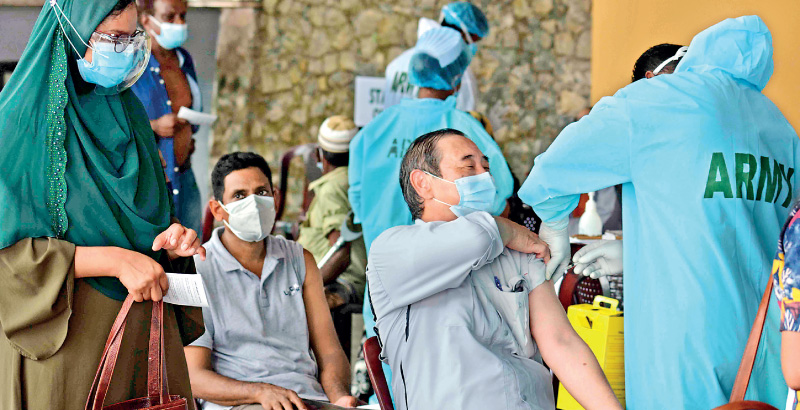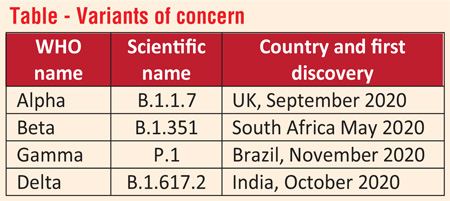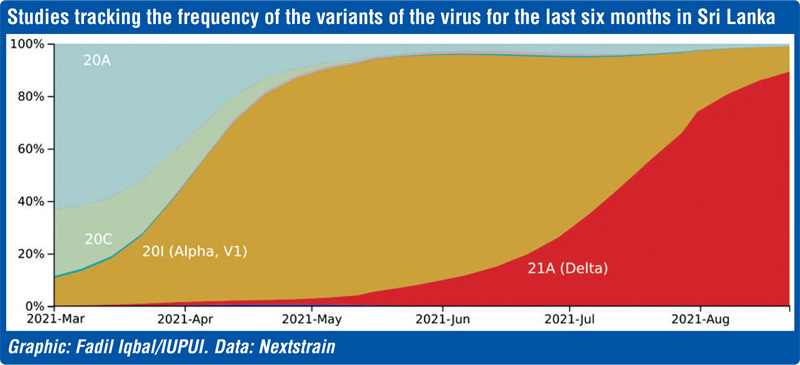Monday Nov 24, 2025
Monday Nov 24, 2025
Thursday, 9 September 2021 00:00 - - {{hitsCtrl.values.hits}}

Vaccinated people can also spread the virus. The vaccines available prevent the occurrence of serious illness from the coronavirus but cannot prevent infections – Pic by Shehan Gunasekara
 The coronavirus has been a game-changer in our lives and acquiring some basic understanding of this virus will help us to counter this invisible enemy.
The coronavirus has been a game-changer in our lives and acquiring some basic understanding of this virus will help us to counter this invisible enemy.
We also acquired a new vocabulary at the beginning of the pandemic: virus, quarantine, lockdowns, social distancing, contact tracing, PCR (which, like Einstein’s famous equation everybody knows but few understand). But new words are being added rapidly – vaccines, immunity, genome, RNA, mutants, variants – that we need to be familiar with.
The scientific output from laboratories and in social media is staggering in their numbers and complexity. Fortunately, many of the scientists as well as science journalists have taken the trouble to explain the developments in corona science. This article is an attempt to explain the mysteries behind mutants and variants of the coronavirus.
Imagine a baby deer that is born in the wild with a deformity (bad variant) hindering its ability to run. It would not survive for long from predators. If the baby deer was endowed with an ability to run faster (good variant) than its predators, it would survive longer in the wild and also produce more deer who can also run faster. This is what Charles Darwin proposed in his ‘Theory of Evolution’ by natural selection.
These changes – deformities and ability to run fast – are brought about by changes to our masterplan in our cells, called the genome. These changes in our genome are called mutations. Evolution by natural selection is a very slow process. The COVID-19 pandemic has fast-forwarded the evolution of the corona virus to unprecedented levels. To understand this, we need an understanding of genomes, mutations, and the spikes on the virus.
 Genome
Genome
The genome is a set of instructions in our cells that makes life possible. The genome is made up of a sequence of chemical compounds called ‘bases’. This is the genetic code. It is ‘written’ using the genetic alphabet consisting of only five ‘letters’. These five letters stand for the five fundamental bases making up the genetic code.
What is commonly called DNA is our genetic code; the genetic code of the corona virus is RNA. The genetic code, written using the five bases or letters, is translated by the machinery of our cells to make proteins. Thus, the primary purpose of the genome is to make proteins. It is the proteins that makes life possible.
Proteins are made up of amino acids. There are 20 amino acids, and a particular combination of these amino acids gives a protein. The genome of the coronavirus is a string of nearly 30,000 ‘letters’ or bases (in comparison, the human genome has three billion letters). These bases are arranged in a precise order to make and assemble the nearly 30 proteins needed to make the coronavirus. That in a nutshell is the basics of the genome of our coronavirus!
Mutations
Let us now see what mutations are. A mutation is simply a change in the letters of the genetic code. These changes (or mutations) in the genetic code in turn results in a change in the sequence of amino acids that go to make protein. When this happens, the proteins formed by the amino acids are also changed.
The virus multiplies by making copies of its genetic code in our cells. During the copying process, occasionally, errors creep into the copies; these errors are called mutations. The genetic code also has a ‘proofreading’ facility (like the spell checker in the computer); this corrects most of the errors.
Many of the mutations are harmless to the virus. If these errors are bad or lethal, the virus would be eliminated and not multiplied anymore. If the error is useful for the virus to infect people more efficiently, then this new virus (or mutant) would increase in number in our throat and lungs. We would then produce and emit more virus particles into the environment when we breathe, talk or sneeze, providing more opportunities to infect others.
The mutant virus is labelled as a variant – a variation of the original virus. When these variants or mutants are identified, they are labelled ‘variants of concern’. They may either have a single mutation or a combination of mutations. When the variants have distinct features such as increased ability to spread, cause more severe disease, or evade vaccines, they are given a name (see below).
Mutations can have serious implications in the English language too. We too make errors when copying a text. Here is a mutated word in a holiday advertisement. A travel company wanted to advertise for an ‘exotic’ vacation. The printer’s devil mutated the ‘x’ to an ‘r’ and the ad read: An erotic travel destination. There were a lot of cancellations from the elderly, but many inquiries from the young! Even the spell checker would have missed this ‘mutant’ word.
Some worrying features of the mutants
Some qualities of the new variants of the virus are a cause of concern to scientists, epidemiologists, vaccine developers and the medical community. These are:
The virus can bind to our cells more efficiently: A variant may have changed its spike (see below) to latch onto our cells more tightly enabling its entry into the cell.
More virus particles are produced in the infected person: If the new mutant virus can increase its multiplication an infected person would release more virus particles into the environment, infecting more people. This is called increased virus shedding.
Better survival in the environment: If the virus survives longer on surfaces in the environment, there is more chance for us to touch the contaminated surface and infect ourselves.
Avoid our defence system: The present vaccines, based on the spike protein of the virus, induce our body to make antibodies. If the spikes are changed by the mutation, they would not be recognised by the antibodies. This happened in South Africa, when the AstraZeneca vaccine was found to be less effective against a new variant of the virus.
Naming the variants
A year after the SARS-CoV-2 virus was discovered, new forms of the virus have emerged from the UK, South Africa and Brazil. These are called new genetic variants of the SARS-CoV-2 virus. A variant is a virus that has new changes in its genetic code, but not enough changes to qualify as a new virus. The variant, called Alpha, was first identified in southern England in September 2020 and has now spread to many countries.
The new variants were initially given alphanumeric names by scientists (an English letter followed by decimals), which is quite complicated to remember for us (B.1.1.7.) let alone for the media to announce on TV or radio. The media overcame this by associating the variant with the country of origin such as the UK variant, South African variant, and Indian variant.
This, however, creates a stigma for the country and the people from those countries. Health and political officials may not like their country to be associated with a virus variant, and they may even suppress the identification of new variants, which is detrimental to controlling the virus.
To overcome the confusion of the scientific names and the geographical stigma the WHO announced on 31 May this year a naming scheme using the Greek alphabet. This is useful for the lay public, media and health officials to communicate easily.
The WHO considers the virus as a Variant of Concern, if it shows increased transmissibility in the population, an increase in virulence or a decline in the effectiveness of control measures. In addition, the WHO also recognises Variants of Interest if the virus has undergone changes that are expected to affect the transmissibility, disease severity, and community transmission in many countries.
These have been assigned the Greek letters Eta, Iota, Kappa and Lambda, which may be promoted to Variant of Concern if they become more important in their occurrence and ability to cause severe disease and signs of escape from the vaccines.
This system is useful if different variants are circulating in a country and to identify which variant is dominant or increasing in a particular region.
Enter the mutants
Mutants arise when the virus is able to undergo many cycles of multiplication in our body. During each cycle of multiplication there is an opportunity for errors to creep into the genetic code. This happens if the virus survives in our body for a long period and if many people are infected. These opportunities provide the virus to multiply many times and accumulate mutations creating new variants of concern.
Can we prevent the emergence of new and more deadly variants of the virus? Yes, by preventing the virus from spreading and multiplying. This can be achieved by our own actions – wearing tight fitting masks, hand washing, social distancing, avoiding unnecessary travel, and also vaccinating ourselves.
The spikes on the virus
The spikes, on the surface of the virus, are the keys the virus uses to gain entry into our cells. The business end of the spike protein is the flower-like structure at the top of the spike. This has to fit into a gateway found on the surface of the cells on our throat and lungs.
If mutations can improve the spike protein to latch onto this gateway (called ACE2), then we have a virus variant with an improved ability to enter our cells.
Spike mutations
Scientists have determined there are 1,273 amino acids that make up the spike protein. There are 20 amino acids and each of them have names and letters of the alphabet assigned to them (e.g., methionine M, phenylalanine F, valine V, leucine L, proline P, alanine A, etc.).
Thus, the amino acids of the spike protein can be written out like this:
MFVFLVLLP… (the rest of the 1,273 amino acids are here)... LHYT.
Thus, a mutation means an amino acid is changed from one form to another or deleted. Here are two mutations:
Amino acid L is deleted: MFVFLVLLP… MFVF (deletion) VLLP…
Amino acid V is changed to A: MFVFLVLLP…. MFVFLALLP…
These small changes or mutations may either have no consequence to the virus or improve its ability to cause infection such as by changing the shape or structure of the spike. If it is bad for the virus (like the handicapped deer) it will be eliminated.
So, how did this virus, the cause of the current havoc in our lives, originate? Scientists speculate that the virus responsible for a previous pandemic in 2002-2003, named SARS-CoV, underwent mutations to its spike protein. The mutations enabled the virus to enter our throat and lungs more easily and bind to our cells much more efficiently and qualified itself to be elevated to a new name for itself – SARS-CoV-2. That, however, is another story.
The Delta variant
The Delta variant or strain is very much in the news today. Compared to the original SARS-CoV-2 virus the Delta variant is able to spread more rapidly – it is more contagious.
A team of scientists in Guangzhou in China compared people infected with the original SARS-CoV-2 virus and the new Delta variant. They studied the daily change in the number of virus particles (called the ‘viral load’). They found the virus could be first detected from people infected with the Delta variant four days after they were exposed to the virus, whereas those infected with the original virus took six days on average. In addition, the viral load was more than 1,000 times as much from the Delta variant.
Thus, this study showed that the increased spread of the Delta variant was due to early release of the virus (i.e., shorter incubation period), and release of much more virus particles, from infected persons. Similar studies with the Delta variant are necessary in other regions to confirm these differences in the behaviour of the virus.
Scientists have looked at the changes to the genome of the Delta variant to understand the rapid spread (it spreads 40% faster than the earlier Alpha variant) of the virus. Scientists from the University of Texas found the mutation caused a small change in the spike of the Delta variant, enabling it to attach itself more tightly to our cells. However, scientists believe that in addition to this mutation there are other changes in the genome that has improved the overall ability of the Delta variant to enter our cells in the throat and lungs with devastating efficiency.
Thus, the evidence points to the Delta variant producing a large number of virus particles in our body, which enters the environment from an infected person (high viral load). The release of the virus by the infected person also occurs a day or two earlier than the original virus – much before the infected person shows any symptoms. These are sufficient ingredients for the virus to spread like a wildfire out of control.
How about vaccinated people? There is evidence from the US, UK and Singapore that vaccinated people who are infected with the Delta variant also have as many virus particles in their nose as unvaccinated people. Thus, vaccinated people can also spread the virus. The vaccines available prevent the occurrence of serious illness from the coronavirus but cannot prevent infections.
On the bright side, studies in Singapore showed that vaccinated people may remain infectious for a shorter period (their viral load drops after around seven days) than unvaccinated people. A single dose of the vaccine was found to be less effective than those who received both doses. Studies from Scotland further suggest that unvaccinated patients are twice as likely to be hospitalised if infected by the Delta variant than by the Alpha variant.
Spread of the Delta variant in Sri Lanka
Studies tracking the frequency of the variants of the virus for the last six months in Sri Lanka, done by the Department of Immunology and Molecular Medicine of the University of Sri Jayewardenepura (USJ), are shown in the figure. This figure is generated by Nextstrain.org, based on data given by scientists from the USJ, and more detailed information is available at their website. This clearly shows the decline in the dominance of the Alpha variant from the period April-May this year and a parallel increase in the Delta variant. At the point of time of the last uploaded data on 22 August, the Delta variant was 89% and the Alpha variant was 10%. Researchers at the USJ have recently reported four mutant Delta variants and two new mutants found in Sri Lanka.
In Sri Lanka, several high-profile cases of infections are seen in the news, some with tragic outcomes. These persons are relatively better isolated than the average person in the street. What could have gone wrong?
One possibility is that they are infected when travelling in their AC vehicles. An AC vehicle has a small volume of space to breathe. The virus can enter this confined airspace from an infected person in the vehicle and then enter through our nose, even if wearing a mask, when we breathe. With an efficient variant like the Delta, even a small viral load can infect us.
Drivers, who spend their day with their colleagues, are a possible source of infection (this of course is no indictment on the drivers). The virus of course knows how it infected us – but then it is not telling us. The bottom line is we need to be extremely vigilant and conscious of how we can be infected.

(The writer is Associate Research Professor, Plant and Environmental Science, National Institute of Fundamental Studies, Hanthane Road, Kandy. He can be reached via [email protected])